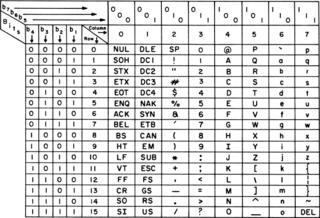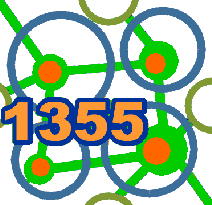
ASCII, an acronym for American Standard Code for Information Interchange, is a character encoding standard for electronic communication. ASCII codes represent text in computers, telecommunications equipment, and other devices. Because of technical limitations of computer systems at the time it was invented, ASCII has just 128 code points, of which only 95 are printable characters, which severely limited its scope. Modern computer systems have evolved to use Unicode, which has millions of code points, but the first 128 of these are the same as the ASCII set.
In computing and telecommunication, a control character or non-printing character (NPC) is a code point in a character set that does not represent a written character or symbol. They are used as in-band signaling to cause effects other than the addition of a symbol to the text. All other characters are mainly graphic characters, also known as printing characters, except perhaps for "space" characters. In the ASCII standard there are 33 control characters, such as code 7, BEL, which rings a terminal bell.
In telecommunication, an End-of-Transmission character (EOT) is a transmission control character. Its intended use is to indicate the conclusion of a transmission that may have included one or more texts and any associated message headings.
In telecommunication, a longitudinal redundancy check (LRC), or horizontal redundancy check, is a form of redundancy check that is applied independently to each of a parallel group of bit streams. The data must be divided into transmission blocks, to which the additional check data is added.
In telecommunication, the term transmission block has the following meanings:
- A group of characters or bits transmitted as a block, unit, message, or packet. It usually includes additional encoded characters for error detection and correction.
- In data transmission, a group of records sent, processed, or recorded as a unit.
Data communication, including data transmission and data reception, is the transfer of data, transmitted and received over a point-to-point or point-to-multipoint communication channel. Examples of such channels are copper wires, optical fibers, wireless communication using radio spectrum, storage media and computer buses. The data are represented as an electromagnetic signal, such as an electrical voltage, radiowave, microwave, or infrared signal.

A serial port is a serial communication interface through which information transfers in or out sequentially one bit at a time. This is in contrast to a parallel port, which communicates multiple bits simultaneously in parallel. Throughout most of the history of personal computers, data has been transferred through serial ports to devices such as modems, terminals, various peripherals, and directly between computers.
The data link layer, or layer 2, is the second layer of the seven-layer OSI model of computer networking. This layer is the protocol layer that transfers data between nodes on a network segment across the physical layer. The data link layer provides the functional and procedural means to transfer data between network entities and may also provide the means to detect and possibly correct errors that can occur in the physical layer.
In data communications, flow control is the process of managing the rate of data transmission between two nodes to prevent a fast sender from overwhelming a slow receiver. Flow control should be distinguished from congestion control, which is used for controlling the flow of data when congestion has actually occurred. Flow control mechanisms can be classified by whether or not the receiving node sends feedback to the sending node.
The C0 and C1 control code or control character sets define control codes for use in text by computer systems that use ASCII and derivatives of ASCII. The codes represent additional information about the text, such as the position of a cursor, an instruction to start a new line, or a message that the text has been received.

IEEE Standard 1355-1995, IEC 14575, or ISO 14575 is a data communications standard for Heterogeneous Interconnect (HIC).
Binary Synchronous Communication is an IBM character-oriented, half-duplex link protocol, announced in 1967 after the introduction of System/360. It replaced the synchronous transmit-receive (STR) protocol used with second generation computers. The intent was that common link management rules could be used with three different character encodings for messages.
Software flow control is a method of flow control used in computer data links, especially RS-232 serial. It uses special codes, transmitted in-band, over the primary communications channel. These codes are generally called XOFF and XON. Thus, "software flow control" is sometimes called "XON/XOFF flow control". This is in contrast to flow control via dedicated out-of-band signals — "hardware flow control" — such as RS-232 RTS/CTS.
ISO 1745:1975 Information processing – Basic mode control procedures for data communication systems is an early ISO standard defining a Telex-oriented communications protocol that used the non-printable ASCII transmission control characters SOH, STX, ETX, EOT, ENQ (Enquiry), ACK (Acknowledge), DLE, NAK, SYN, and ETB.
In data networking, telecommunications, and computer buses, an acknowledgment (ACK) is a signal that is passed between communicating processes, computers, or devices to signify acknowledgment, or receipt of message, as part of a communications protocol. Correspondingly an negative-acknowledgement is a signal that is sent to reject a previously received message or to indicate some kind of error. Acknowledgments and negative acknowledgments inform a sender of the receiver's state so that it can adjust its own state accordingly.
IEC 60870 part 5 is one of the IEC 60870 set of standards which define systems used for telecontrol in electrical engineering and power system automation applications. Part 5 provides a communication profile for sending basic telecontrol messages between two systems, which uses permanent directly connected data circuits between the systems. The IEC Technical Committee 57 have developed a protocol standard for telecontrol, teleprotection, and associated telecommunications for electric power systems. The result of this work is IEC 60870-5. Five documents specify the base IEC 60870-5:
Six-Bit Transcode, or Six-Bit Transmission Code, was, for a few years, one of the three character sets used by IBM for Binary Synchronous Communications. Transmission using 6-bit Transcode had higher throughput than transmission using 8-bit EBCDIC or ASCII, provided that the data to be transmitted used a limited set of 48 characters.
Synchronous transmit-receive (STR) was an early IBM character-oriented communications protocol which preceded Bisync. STR was point-to-point only, and employed a four-of-eight transmission code, communicating at up to 5100 characters per second over half-duplex or full-duplex communication lines.
Synchronous serial communication describes a serial communication protocol in which "data is sent in a continuous stream at constant rate."


